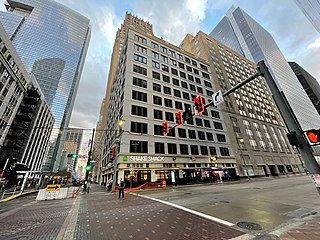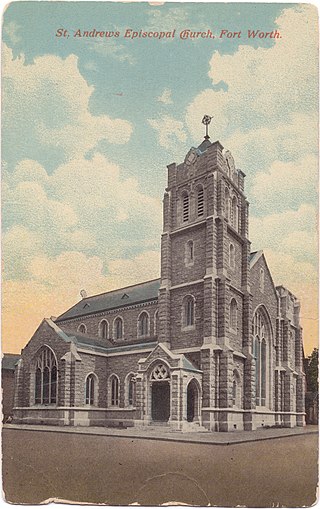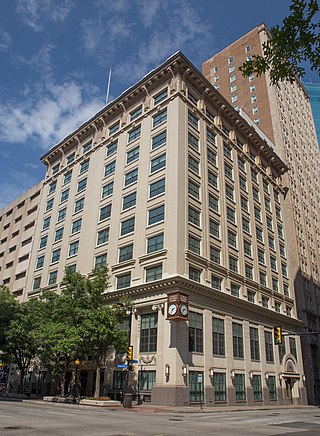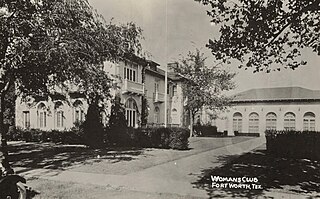
South Main Baptist Church is a Baptist church in Houston, Texas. Located in Houston's midtown area, the church has a long history in the city. The church was named "Church of the Year" by Guideposts Magazine.
Wyatt Cephus Hedrick was an American architect, engineer, and developer most active in Texas and the American South. He began his career as an engineer, working in Virginia and Texas. He started his own firm in Fort Worth, and later merged with the architecture firm of Sanguinet & Staats before buying out the interests of the senior partners.

Alfred Charles Finn was an American architect. He started in the profession with no formal training in 1904 as an apprentice for Sanguinet & Staats. He worked in their offices in Dallas, Fort Worth, and Houston. His credits during his tenure residential structures, but firm was a leader in steel-frame construction of skyscrapers.

The Great Jones Building is a building in Downtown Houston at the intersection of Capitol Street and Main Street.
The Robert A. Welch Hall is a building located on the University of Texas at Austin campus in Austin, Texas, United States.

St. Andrew's Anglican Church is a parish of the Episcopal Diocese of Fort Worth in the Anglican Church in North America. Established as a mission church in 1875, it is the oldest continuous Episcopal/Anglican presence in Fort Worth. In the late 20th and early 21st centuries, it played a role in the Anglican realignment in North America.

Lang & Witchell was a prominent architectural firm in Dallas, Texas, active from 1905 to 1942.

The William J. Bryce House, known as Fairview, is located on 4900 Bryce Avenue in Fort Worth, in the U.S. state of Texas.
Thomas Edward Stanley II was a Dallas-based American architect. He is known for his modernist glass and steel designs for buildings such as 211 North Ervay (1958) with architect Wyatt C. Hedrick and the First National Bank Tower (1965) with architect George Dahl. He is also known for his use of minimalist classical designs for buildings such as the Sanger-Harris department store (1965) in Dallas, Texas and the Cambridge Tower (1965) in Austin, Texas.

The JW Marriott Downtown Houston is a hotel located at 806 Main Street in Downtown Houston, which opened in 2014. It had been previously known as the Carter Building, and was the tallest building in Texas when it opened in 1910. The building was renamed Second National Bank Building in 1923.

The State National Bank Building is a high-rise office building located at 412 Main Street in downtown Houston, Texas. Designed by architect Alfred Charles Finn, the building was built in 1923 in the Spanish colonial style. It was listed on the National Register of Historic Places on August 11, 1982.
The Baldridge House is a historic three-story mansion in Fort Worth, Texas, U.S. It was built from 1910 to 1913 for Earl Baldridge, a cattleman and rancher who later became a banker, and his wife Florence. It was designed by Sanguinet & Staats. It was purchased by Paun Peters, the president of the Western Production Company, in 2007. It was listed for sale for $8 million in 2017.
Courtlandt Place, Houston is a residential subdivision consisting of a single street, south of downtown Houston, planned in 1906. Courtlandt Place is a member of the Neartown Houston Association.

James L. Autry House is located at 5 Courtlandt Place in Houston, Texas, and is listed on the National Register of Historic Places. Design is credited to Alfred C. Finn, when he worked for the Fort Worth architecture firm of Sanguinet & Staats, and was executed in 1912. Autry was a general counsel and director for Texaco.

First National Bank Building, at 711 Houston St. in Fort Worth, Texas, was built in 1910. It was designed by Sanguinet & Staats with Wyatt C. Hedrick. It has also been known as Baker Building and as Bob R. Simpson Building.

The Woman's Club of Fort Worth is one of the city's oldest membership organizations, formed in 1923 by the members of several existing woman's clubs. The Woman's Club complex comprises eight historic buildings on Fort Worth's Near Southside and was listed on the National Register of Historic Places in 2017. As with many woman's clubs in the United States, the Woman's Club of Fort Worth has its roots in the Progressive Movement, with its original mission of "the cultural and civic advancement of Fort Worth; and the study of literature, history, science, painting, music, and other fine arts."

Witt, Seibert & Halsey was an American architectural firm based in the twin cities of Texarkana, Arkansas and Texarkana, Texas, with a practice extending into Arkansas, Louisiana and Texas. It was founded by architect Sidney Stewart, but achieved prominence under Bayard Witt and Eugene C. Seibert.

Charles D. Hill was an American architect practicing in Dallas, Texas during the first three decades of the twentieth century.
Preston Murdoch Geren Jr. was an American architect. A lifelong resident of Fort Worth, Texas, Geren designed or served as associate architect for many of Fort Worth's most notable buildings constructed during his working life.
Preston Murdoch Geren Sr. was an American architect and engineer. Part of a prominent architectural family in Texas, he designed or served as associate architect for many of Fort Worth's most notable buildings constructed during his working life.












